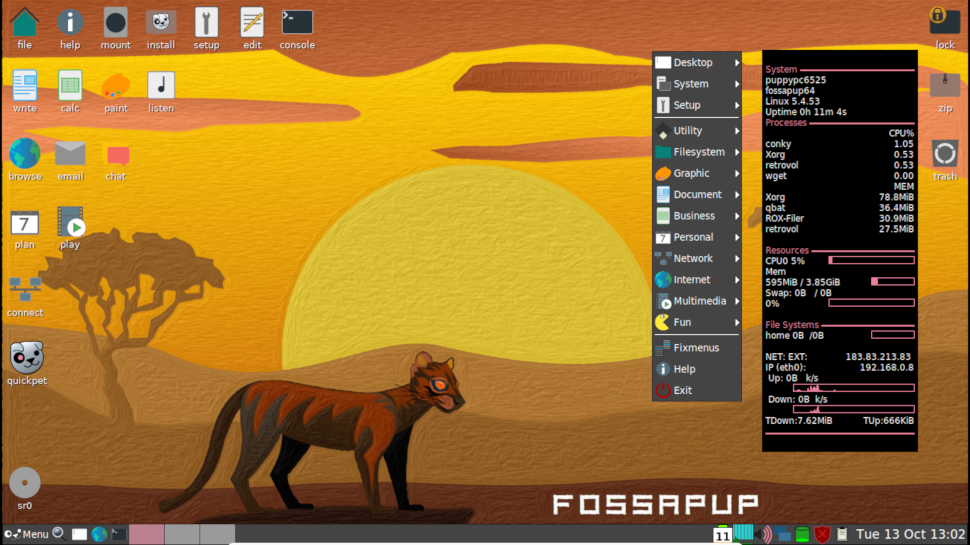TechRadar Verdict
An Ubuntu 20.04 Focal Fossa-based Puppy that delivers all the Puppy goodness on top of an Ubuntu LTS foundation.
Pros
- +
Lightweight
- +
Brimming with apps
- +
Multiple installation mechanisms
Cons
- -
Tricky UI
Why you can trust TechRadar
Puppy’s Ubuntu-based release has had a major update and is now based on Ubuntu 20.04 Focal Fossa. This means that FossaPup64 9.5 (which also goes by the much easier nomenclature, Puppy Linux 9.5) is binary compatible with the latest Ubuntu LTS release and can pull applications from its repositories without any issues.
This release is the fourth official release of an Ubuntu-based 64-bit Puppy. Like all Puppy distros, FossaPup64 is built using the Woof-CE build system that’s designed to assemble Puppy variants from the binary packages of any other distro.
A key feature of the official Puppy releases is that they’re modular. You can easily swap out components including the kernel and various programs to create a streamlined Puppy.
- These are some of the best lightweight distros
- Here are some of the best laptops for running Linux
- We've also rounded up the best Linux VPN services
This review first appeared in Linux Format Magazine, Issue #270, published in December 2020.
Puppy also isn’t a multi-user distro like most others. FossaPup64 runs everything as root by default, though you can ask it to run some of the key Internet-facing tools as a non-root user called spot, for additional security.
However, you can run the distro without worrying about any of these things. You can use it ‘as is’ and leave the tweaks to experienced users who know what they’re doing. Puppy takes pride in the fact that it can be used by anyone and that’s true to quite an extent.
Puppy Linux can run from all sorts of removable media. Although it’s best used from a USB stick, you do have the option of anchoring it to the hard disk. Puppy offers two installation mechanisms. The recommended Frugal mechanism copies Puppy files inside any partition that could even hold another distro. This method supports UEFI as well. A default frugal install takes slightly over 400MB, but you can remove the modules for an even smaller installation.

Then there’s the Full installation option that takes over the entire partition and is traditionally recommended only for older machines. Puppy’s installation process is rather unconventional, but can easily be navigated by first time users, especially since every step is well documented and easy to follow.
Sign up to the TechRadar Pro newsletter to get all the top news, opinion, features and guidance your business needs to succeed!
Brown Puppy
The one thing that always amazes us about Puppy is its default cache of apps. Despite its miniscule size, there’s no beating Puppy for out-of-the-box functionality and there’s an app for virtually every task that you can perform on a desktop.
It’s no surprise that Puppy skips over mainstream programs in favour of lightweight options. The most iconic are its use of Joe’s Window Manager and the fox-filer file manager that give it its distinctive appearance.
There’s also Claws Mail, Pale Moon web browser, AbiWord editor, mpv multimedia player and more. Interspersed with them are Puppy’s own custom tools primarily to ease administration tasks. First-time users will be surprised that the tiny distro includes some programs that you wouldn’t find even in full-fledged distributions, including utilities to block online ads, a softphone for internet telephony and more.
For package management tasks you can use the distro’s custom Puppy Package Manager tool. By default it’ll fetch programs from Focal Fossa, but you can configure it to download packages from other Puppy repositories, too. First timers might prefer to use Quickpet that’ll easily install several mainstream open source and proprietary programs with a single click.
When you shut down a Live session, Puppy offers to save all the changes inside a file that can optionally be encrypted for added security. Interestingly, the distro can also save changes from a Live session onto rewritable optical media.
| Developer | Philip Broughton | Row 0 - Cell 2 | Row 0 - Cell 3 |
| License: | GPL and others | Row 1 - Cell 2 | Row 1 - Cell 3 |
| Features | 9/10 | Ease of Use | 7/10 |
| Performance | 9/10 | Documentation | 7/10 |
| Overall Rating | 8/10 | Row 4 - Cell 2 | Row 4 - Cell 3 |
With almost two decades of writing and reporting on Linux, Mayank Sharma would like everyone to think he’s TechRadar Pro’s expert on the topic. Of course, he’s just as interested in other computing topics, particularly cybersecurity, cloud, containers, and coding.

